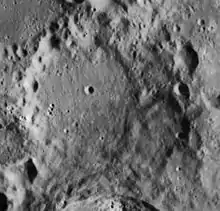Blanchinus (crater)
Blanchinus is a lunar impact crater that is situated in the rugged south-central highlands of the Moon. The crater is named after Italian astronomer Giovanni Bianchini whose Latinized name is Blanchinus.[1] Adjacent to the south of Blanchinus is the crater Werner, and La Caille is attached to the northwest rim. West of the crater is the prominent formation Purbach.
 Lunar Orbiter 4 image | |
| Coordinates | 25.4°S 2.5°E |
|---|---|
| Diameter | 58 × 68 km |
| Depth | 4.2 km |
| Colongitude | 358° at sunrise |
| Eponym | Giovanni Bianchini |
The outer rim of Blanchinus has been significantly degraded by subsequent impacts, leaving an irregular, notched exterior ring of rugged hills and ridges. The inner floor, in contrast, is nearly flat and free of significant impacts. Only a few tiny craterlets mark the interior surface, with Blanchinus M located near the midpoint and the remainder lie near the southwest rim.
For a few hours before the first quarter, the crater's rim contributes the lunar x visual phenomenon.
Satellite craters

By convention these features are identified on lunar maps by placing the letter on the side of the crater midpoint that is closest to Blanchinus.
| Blanchinus | Latitude | Longitude | Diameter |
|---|---|---|---|
| B | 25.2° S | 1.6° E | 8 km |
| D | 25.0° S | 4.2° E | 7 km |
| K | 24.8° S | 5.1° E | 9 km |
| M | 25.2° S | 2.6° E | 5 km |
References
- "Blanchinus (crater)". Gazetteer of Planetary Nomenclature. USGS Astrogeology Research Program.
- Andersson, L. E.; Whitaker, E. A. (1982). NASA Catalogue of Lunar Nomenclature. NASA RP-1097.CS1 maint: ref=harv (link)
- Bussey, B.; Spudis, P. (2004). The Clementine Atlas of the Moon. New York: Cambridge University Press. ISBN 978-0-521-81528-4.CS1 maint: ref=harv (link)
- Cocks, Elijah E.; Cocks, Josiah C. (1995). Who's Who on the Moon: A Biographical Dictionary of Lunar Nomenclature. Tudor Publishers. ISBN 978-0-936389-27-1.CS1 maint: ref=harv (link)
- McDowell, Jonathan (July 15, 2007). "Lunar Nomenclature". Jonathan's Space Report. Retrieved 2007-10-24.CS1 maint: ref=harv (link)
- Menzel, D. H.; Minnaert, M.; Levin, B.; Dollfus, A.; Bell, B. (1971). "Report on Lunar Nomenclature by the Working Group of Commission 17 of the IAU". Space Science Reviews. 12 (2): 136–186. Bibcode:1971SSRv...12..136M. doi:10.1007/BF00171763.
- Moore, Patrick (2001). On the Moon. Sterling Publishing Co. ISBN 978-0-304-35469-6.CS1 maint: ref=harv (link)
- Price, Fred W. (1988). The Moon Observer's Handbook. Cambridge University Press. ISBN 978-0-521-33500-3.CS1 maint: ref=harv (link)
- Rükl, Antonín (1990). Atlas of the Moon. Kalmbach Books. ISBN 978-0-913135-17-4.CS1 maint: ref=harv (link)
- Webb, Rev. T. W. (1962). Celestial Objects for Common Telescopes (6th revised ed.). Dover. ISBN 978-0-486-20917-3.CS1 maint: ref=harv (link)
- Whitaker, Ewen A. (1999). Mapping and Naming the Moon. Cambridge University Press. ISBN 978-0-521-62248-6.CS1 maint: ref=harv (link)
- Wlasuk, Peter T. (2000). Observing the Moon. Springer. ISBN 978-1-85233-193-1.CS1 maint: ref=harv (link)
External links
| Wikimedia Commons has media related to Blanchinus (crater). |
- Nemiroff, Robert; Bonnell, Jerry (December 10, 2016). "The Lunar X". Astronomy Photo of the Day (APOD).
